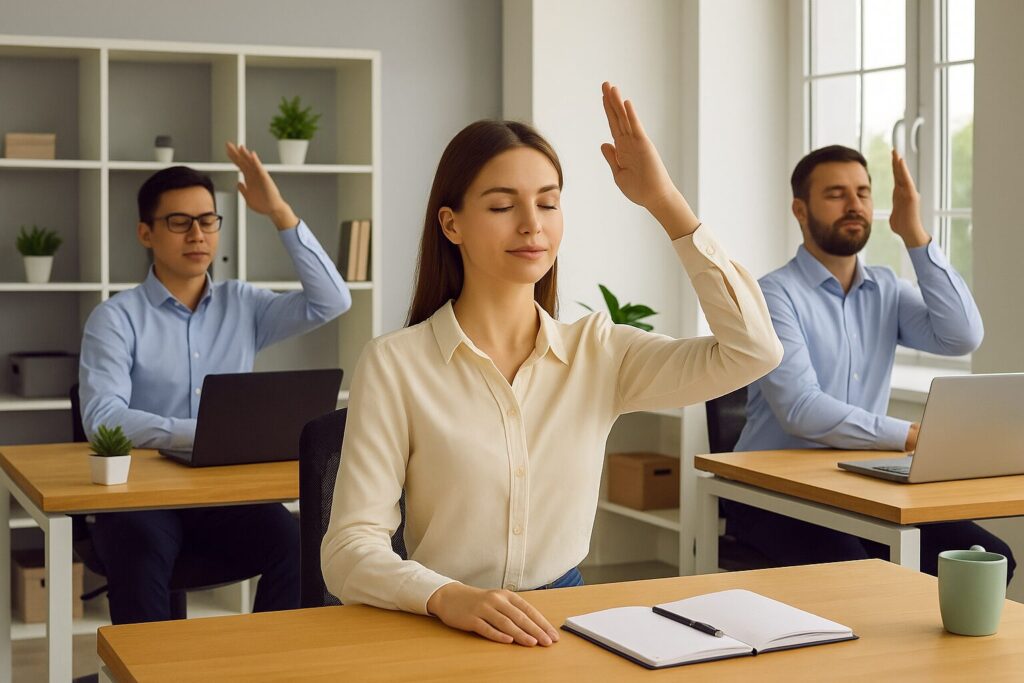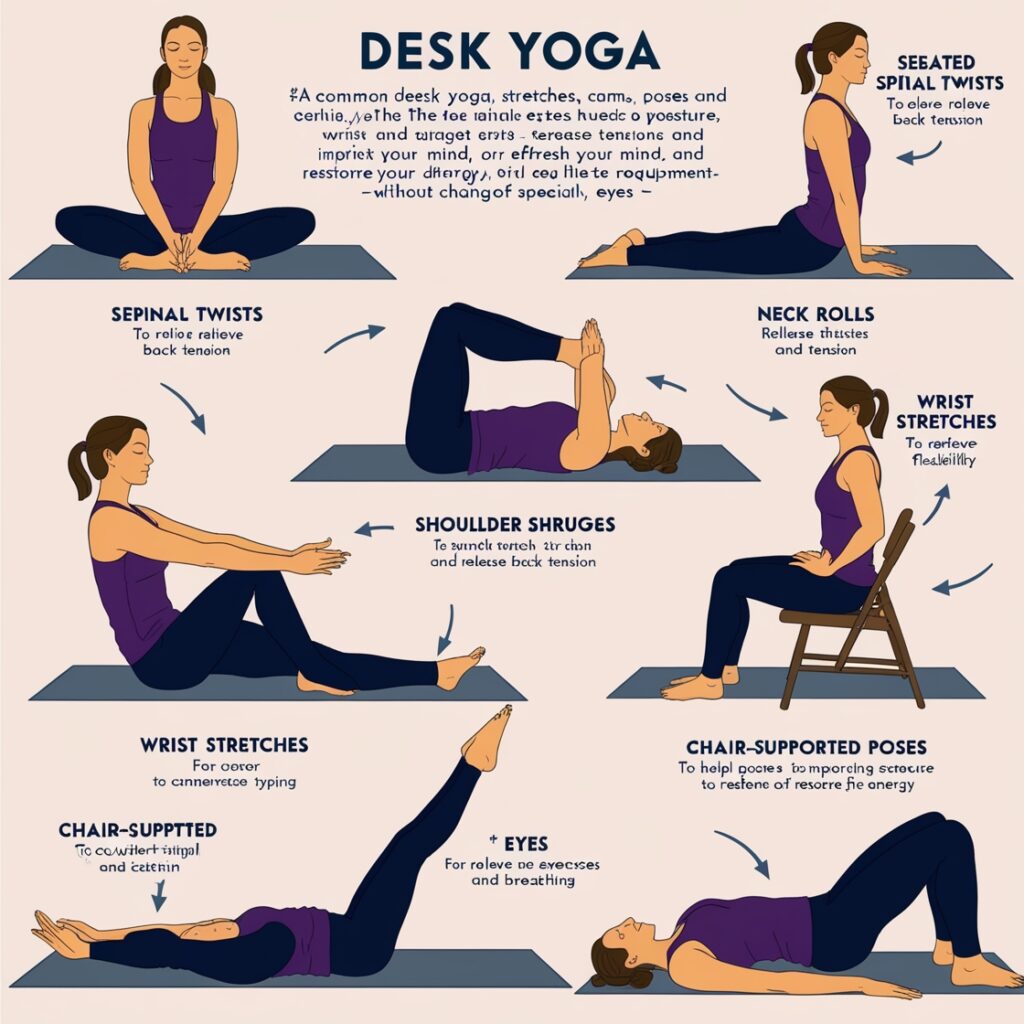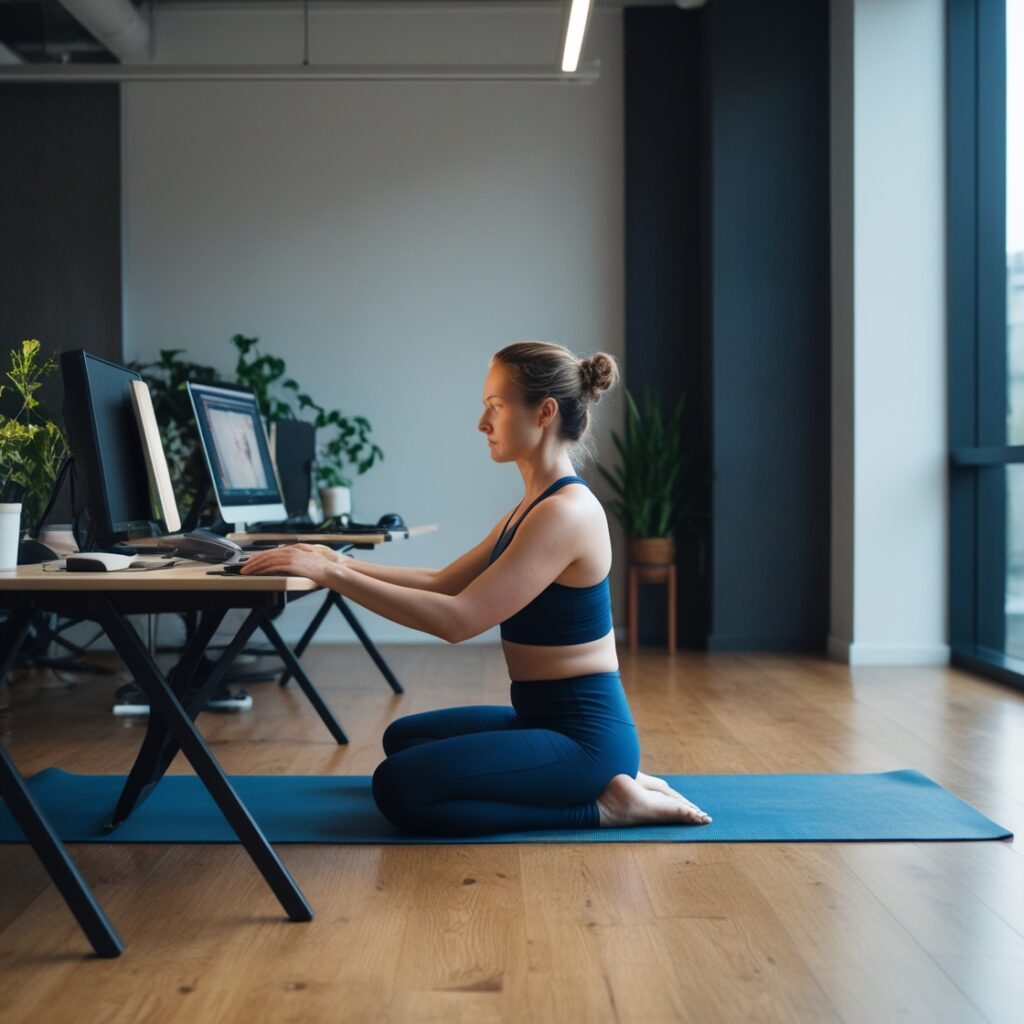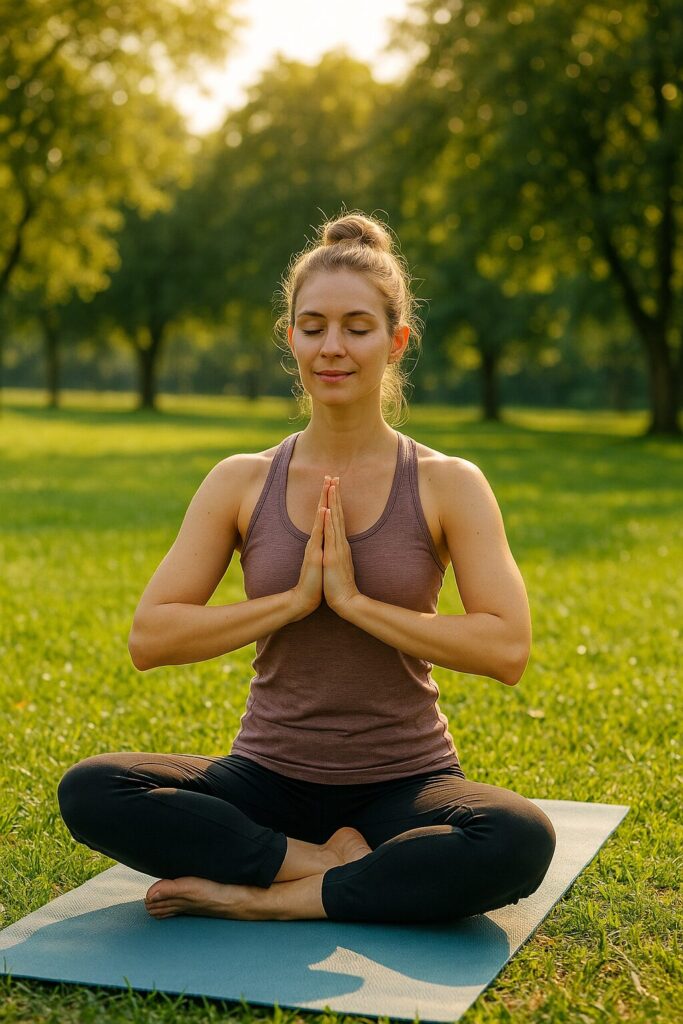DESK YOGA AT WORK
Introduction: People, at large, are running from morning to evening for earning their livelihood, but they don’t pay heed to their physical needs. Desk Yoga is emerging as a practical solution in this fast-paced, screen-dominated culture where most office workers spend hour after hour over their laptops or desktops, barely find time to move from their chairs when their minds are running at full speed, and the resultant effect is to pay a heavy price. Some common physical problems often arise in office workers, like neck stiffness, tight shoulders, backaches, mental fatigue, etc.
But if you refresh your body and mind by spending a few minutes on Desk Yoga? This will give you a miraculous result.
Desk Yoga is a simple and effective practice that brings the ancient wisdom of yoga into the modern workplace. You don’t need any Yoga Mat, Yoga Dress, and you don’t need to leave the workplace to practice Yoga. Only you have to spend a few valuable minutes for stretching, breathing, and mindful movement, which will help you to get some powerful difference in your vigor and thought process. Desk Yoga not only provides physical relief but also mental relief. Taking a short break for Desk Yoga can recharge, refocus, and return to your tasks with more energy and clarity, whether you are battling deadline stress or post-lunch drowsiness.
Desk Yoga is important for those who are spending long hours in the office with a tight schedule or working from home, where movement is minimal. Desk Yoga fits into your daily routine when you are fully absorbed in your work with some intervals.

1. What is Desk Yoga: Desk Yoga is a gentle form of Yoga which is useful for people who spend long hours sitting at a Desk may be at the Office or working from Home. The traditional yoga requires generally a Yoga Mat, Open Space, but Desk Yoga can be performed at the workplace itself without leaving the Chair.
Desk Yoga comprises a series of simple stretches, poses, and breathing exercises that help relieve the strain. Its goal is to release the built-up tension, improve posture, refresh the mind, and restore energy without needing a change of special clothing or equipment.
2. The problem we generally face: The Office Chair is the New Health Risk – Today’s workspaces, whether at a Corporate Office or home setups, are not designed with your physical setup and mind. Most of the office workers spend nearly 8-10 hrs. a day seated, often in poor posture – shoulders hunched, spine curved, and eyes fixed on the screen may be on a desk top, laptop, or your phone. Over time, this sedentary lifestyle leads to a serious toll on both physical health and mental well-being.
The physical problems we generally face are:
- Chronic Neck and Back Pain
- Tight Hips and sore Wrists
- Eye fatigue and mental tension with a headache
- Energy deficiency and lack of focus
- Heightened stress and excessive burnout.
Moreover, the above problems go unnoticed until they create severe physical problems. Even after facing these problems, we attend meetings, phone calls, and give utmost importance to attain the deadlines, but our body slowly absorbs the pressure. Overtime, stress compounds, postures worsen, and ultimately, the productivity drops.
The modern Desk jobs disconnect us from our bodies, making us feel stiff, sluggish, and mentally drained.
3. Solution: You don’t need to attend Doctors frequently and spend a huge amount of your hard-earned money, and also you don’t need to change your entire lifestyle to get rid of the problems. Your solution lies in small, mindful movements at your desk. This is where Desk Yoga comes in.
Desk Yoga is a modern approach to traditional yoga designed particularly for people who spend a long time at their desks. It combines gentle stretches, deep breathing in fresh air, and some subtle postural adjustments that can be done in your chair itself, and if possible, some fresh air. Those who spend a long time in a glowing screen, wash your eyes and see some greenery outside without needing a Yoga Mat, Special Yoga clothes, and Yoga equipment.
4. Practice of Desk Yoga helps to:
- Release built-up tension
- Improves Blood circulation
- Calms the nervous system
- Promotes physical awareness
- Boosts energy
You don’t need to dedicate a long hour to practice or attend regular practice at the training center. You only need to dedicate 10-15 minutes to reset your body and mind. This Desk Yoga will help you to achieve wellness habits that bring Yoga off the mat into real life, right where you need it most.
When you practice it consistently, it works more than a quick fix. It is a preventive, empowering routine to help you stay focused, flexible, and grounded through the workday.
5. Benefits of Desk Yoga at the Workplace:
i. Relieves Back and Neck Pain: Long hours of Desk work create tension in the neck, shoulders, and lower back. Desk Yoga stretches help to loosen the neck, shoulder, and lower back portion of our body and reduce the pressure created on the spine. A few minutes of Shoulder Roll and Spinal Twists reduce the stiffness and restore natural alignment.
- KEHUNI NAMAN
- SKANDHA CHAKRA
- GREEVA SANCHALANA
These are the highly effective poses to reduce back and Neck Pain.
ii. Improves Posture: Bending down on the screen of Laptops/Desktops/phones causes poor posture habits like rounded shoulders and forward head tilt. Desk Yoga helps to improve body awareness and strengthen postural muscles, and also helps to sit straight upright and avoid long-term damage.
- ANANDA MADIRASANA
- VAJRASANA
- PADADHIRASANA
The above postures are the ideal Asanas for strengthening postural muscles and to sit upright and avoid long-term damage.
iii. Boosts Energy and Reduces Fatigue: Sitting long hours generally causes sluggishness in the evening hours. This is generally seen in every person sitting for long hours. Gentle yoga postures with Pranayama increase the blood flow with fresh oxygen to the brain and provide a natural energy boost. No hot tea or coffee is required for an energy boost. A few yoga postures with Pranayama will help you return to the tasks with renewed energy and clarity.
- PADMASANA
- ANULOM – VILOM Pranayama
The above is the ideal Asana with Pranayama provides renewed energy and helps to avoid long-term damage.
iv. Enhances Focus and Concentration: Mindful breathing at the desk is extremely important for balancing focus on work. When the body is relaxed and inhalation and exhalation is equal, the cortisol level is reduced, keeping the mind calm even if you are in hot meeting.
ANULOM – VILOM PRANAYAM (With equal number of inhale and exhale and a second or two for retention).
v. Reduces Stress and Anxiety: Desk Yoga helps to activate the parasympathetic nerves, which help to calm the nerves. Pranayama, like Deep Belly breathing, is also extremely helpful to reduce stress and anxiety.
PADMASANA – This is a posture that applies pressure to the lower spine, which has a relaxing effect on the nervous system. The breath becomes slow, muscular tension decreases, and blood pressure is reduced, thereby reducing the stress and anxiety.
vi. Improves Flexibility and Mobility: Prolonged sitting on a chair shortens and tightens the muscles, especially in the hips and hamstrings. Here, Desk yoga helps to gently introduce movement in these areas, improve flexibility, and reduce the risk of joint stiffness and injury.
- GOOLF NAMAN
- GOOLF CHAKRA
- GOOLF GHOORNAN
- JANU NAMAN
- JANU CHAKRA
The above are extremely helpful to improve movement, flexibility, risk of joint stiffness and injury.
vii. Supports Eye Health: Staring at the glowing screen for long hours causes digital eye strain and headaches. Desk Yoga helps to relax the eye muscles, improve focus, and reduce screen-related problems.
- PALMING
- SIDEWAYS VIEWING
- FRONT AND SIDEWAYS VIEWING
- ROTATIONAL VIEWING
- UP AND DOWN VIEWING
The above are like a reset button for the eyes, face, and forehead.
viii. Boosts Productivity: The energized and relaxed body supports a sharp mind. Your brain gets reset if you take a short break from your desk. This leads to fewer mistakes, better decision making, and highly quality output.
- Promotes better Breathing: Sitting for a long period in the Chair restricts deep breathing. Desk can help Deep Belly Breathing, which improves oxygen flow, lowers anxiety, and refreshes throughout the day.
- Boosts Mood and Confidence: Every movement releases Endorphin, which is a natural feel-good chemical that boosts and reduces emotional tension.

6. Real Life Story: How Desk Yoga transformed a Computer Engineer’s Life:
While I was travelling by train from Bangalore, a tech city of India, to Delhi (the capital city of India), I met a very energetic man, nearly 31 years named Rahul, who is also living in Delhi. While gossiping about various issues in our lives, certain dramatic situations he faced came out. As he told, like many in his field, he revolved around long hours in screen time, attending endless client calls, and back-to-back deadlines.
He was apt in coding and, therefore, he used to spend long hours at the screen, but some time back, his body started to revolt. It began subtly. Initially, he faced constant neck pain, which he blamed on pillows. After a few days, he faced stiffness in his lower back and which worsened by evening. He could not stay long at his desk. He was compelled to leave his office. Thereafter, more physical problems cropped up. Sleep became erratic – four to five hours of tossing and turning. He felt irritable, his digestion became sluggish, and he began to experience acidity after his dinner. He also felt constant fatigue, even after his morning coffee.
He became a usual latecomer at his office. He could not pay full attention to his work. One day, one of his friends, hearing all these problems, recommended him to attend Desk Yoga and a Lifestyle wellness plan. He grabbed the advice and signed up for the same.
The program was structured and simple.
- 25 Minutes of guided yoga daily – focus on back bends, twists, and shoulder shrugging.
- Two easy Pranayama (Nadi Sodhana and Bhramari) to ease his mind
- Short Screen Breaks every 90 minutes, just to stretch and breathe
- Early Light Dinner and warmer and well-cooked meals instead of Sandwiches.
- A soothing cup of Brahmi Tea every night and a weekly Abhyanga Massage to relax his nervous system
- One Ashwagandha Capsule in the evening to balance stress
Just after 6 weeks, a remarkable transformation was noticed:
- His back pain and neck stiffness were reduced by 80%
- He started sleeping 7-8 hrs. without waking up
- His mood improved, so his focus and productivity increased
For him, Desk Yoga was not a trend; it helped him to reclaim his health and peace in mind without leaving his job or making any drastic change.
I heard his story and was charmed. Therefore, I also advise my readers to give it a try, if they face such of problem.
7. Common Myth and Misconception of Desk Yoga: In spite of its growing popularity, it is still misunderstood by many young office workers. Let us clear the common myth and misconception about Desk yoga and embrace it for your well-being.
Myth 1 – Need to be flexible to perform Desk Yoga: The Desk is designed for all body types and fitness levels. It focuses on gentle movements and breathing, even simple stretches, shoulder rolls or seated twists provide huge benefits.
Myth 2 – I don’t have time for Yoga: In this case, you only need 4-5 minutes at a time. A quick stretch during the lunch interval can relieve your tension and refresh your mind.
Myth 3 – I need a Yoga Mat and workout clothes: It is not at all true. For Desk Yoga, neither you need a Yoga Mat nor Workout clothes.
Myth 4 – I feel shaky in front of Co-workers: In recent times, workplaces are welcoming Yoga practices. Your co-workers are facing the same problems as you. So, don’t hesitate to start Desk Yoga without drawing anyone’s attention.
Myth 5 – It is not as effective as regular yoga classes: Yes, it does not replace a full workout, but Desk Yoga can fill the gap. It can reduce your neck pain, improve focus, and lower stress. All these are crucial for office workers.
The desk is simple, discreet, and powerful. Once you start, you will wonder why you have not started it earlier.
8. Conclusion: In today’s fast-paced work environment, we usually forget that our body is a valuable asset. Sitting long hours on the chair, avoiding breaks for achieving targets, and working under constant pressure seem like the path to achieve productivity, but ultimately, they silently wear us down. Ignoring physical discomfort, we invite chronic pain, stress, poor posture, and burnout. But if we practice Desk Yoga, we can protect our health without stepping away from our responsibilities.
Just practicing a few minutes of Desk Yoga, we can realign our posture, avoid chronic pain, and neck stiffness. It can also protect and help us to :
- Protect common Office-related health issues
- Improve focus and mental clarity
- Boost energy and mood
- Help us to feel more balanced and controlled
It is not a luxury; it is a necessity for our long-term wellbeing. When we respect our body, our body will also protect us in turn. Desk is a simple but powerful way to honor both.
You don’t need more hours throughout the day – just a few mindful minutes to take care of the body that carries us through it.
FQA :
- Question: Can Desk Yoga help you stay active?
Ans: Yes, Desk Yoga helps us to stay active throughout the day. It can improve our performance and boost energy to feel rejuvenated.
- Question – Is Yoga at work worth it?
Ans: In a world where most jobs demand long hours of sitting, screen time, and high mental pressure, yoga at work isn’t just beneficial—it’s essential. You don’t need a yoga mat, workout clothes, or an hour of free time. Even short, simple movements or breathing exercises at your desk can make a real difference.
- Question: Can Desk Yoga improve productivity?
Ans: Yes! Desk Yoga isn’t just about stretching your body—it’s about resetting your mind, energy, and focus throughout the workday. When your body feels good, your brain works better. And that translates directly to how much you get done—and how well you do it.
- Question: Do I need a Yoga Mat and to change clothes?
Ans: No, you don’t need any Yoga Mat and to change clothes. Only you need to spend some mindful stretching and a Chair.
- Question: How often should I practice?
Ans: 2-3 minutes a day for a few minutes is enough for your benefit.







great submit, very informative. I wonder why the opposite experts of this sector
do not understand this. You must continue your writing.
I am confident, you’ve a huge readers’ base already!
Respected Sir,
Extremely glad to read your encouraging message. Shall try to write more informative articles which will make you happy. Your blessing is my progressive energy.
Regards
Hmm is anyone else experiencing problems with the images on this blog loading?
I’m trying to figure out if its a problem on my end or if
it’s the blog. Any feedback would be greatly appreciated.